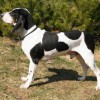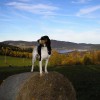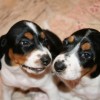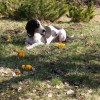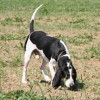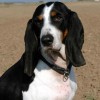Hájemství bernských honičů :: Bohemia Hill
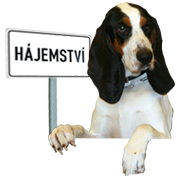
Our achivements
N E W S F L A S H ! CELER CERVARIUS (BODIE) = WORLD WINNER + HUNGÁRIA JUNIOR CHAMPION!
Our achivements - titles:
4x World Winner, 4x Champion International d´Exposition, 14x Champion, 4x Juniorchampion, 2x Veteran Champion, 2x I.BIS -Best Puppy, II. BIS - Best Veteran, I. BOG, II.BOG, IV.BOG,
Bernese weekly
Bernese hounds
02.03.2011abbreviated text of an article published in the Animals´Planet Magazine, year 2005, issue 11 (author: Radana Mensikova, kennel Bohemia Hill)
A bit of hunting hound history
Hunting scenes with dogs can be found deep in the history; already in the tombs of ancient Egypt we can see hunting scenes and similar findings were discovered also at other places, e.g. in Sweden, Spain and Southern France.
As we can learn from the work of Greeks (Xenofon) as well as Roman (Columela) writers, in the classic age dogs were already divided among hunting, sheperds´ and guard dogs. Good hunting hounds received high acknowledgement with ancient Germans who punished the theft or killing of a hunting hound severely.
The hunting gradually became a privilege of the free; hunting hounds were kept mainly by noblemen. For instance in France breeding of the hunting hounds was of guite a high level until 18th century; a change was brought on only by Great French Revolution.
The idea of breeding dogs in a manner similar to breeding of noble horses (ie. with a pedigree) was asserted in England in the 19th century. There, the main perspective was no longer the dog´s usability but also the noble appearance. Exhibitions of dog beauty started and, gradually, the first standards were originated for individual breeds.
Hounds
The majority of today´s hound breeds originate from the south and it is believed that they arrived to central and nothern Europe from the Mediaterranean. The Celts probably kept hounds since they enjoyed hunting and gradually inhabited not only the territory of present day France, Spain and western Switzerland but also the British Isles.
Germans who arrived to the terittory of today´s Switzerland and southern Germany also had game cources and, how it ensues from ancient German laws, the Leges barbarorum (5th to 9th century), they overtook the Celts´dogs. Of the original Latin dog names the various designations originated that are used up to the present day, for instance the segugio, sabueso, or braka.
"The Golden Era" of the great hunts was in the 17th and 18th centuries which was a time of parforce hunts; that meant a prime and further development of hunting hound breeds all over Europe (for instance in France a number of noble families kept kennels of hunting hounds and were proud of their own "breeds"). Parforce hunts were very expensive and, originally, followed a strict ceremony. However, in the course of time they degenerated and became rather dubious entertainment.
Hounds in Switzerland
I cannot but start with a quote from Hans Räber´s book Encyklopedia-Dog Breeds: "Swiss hounds rank amongst the oldest hound representatives and it is a shame that numbers of these wonderful dogs diminish steadily."
Originally there were five independent types of hounds in Switzerland and it is maintained that the types were kept absolutely separately for quite a long time. At the Aarburg exhibition in 1882 a number of various hounds were presented - the individual types differed types in colour, size and type; one could see 5 basic forms there.
At the turn of the 19th and 20th centuries it seemed that it was the end of the Swiss hound; in 1903, however, a special club for these hounds was established in Switzerland and the club officials did everything to save the breed. The conditions have improved gradually and since 1931 we can speak of a new breeding construction. In 1933 the first uniform standard was issued; in that time the individual types of Swiss hounds only differed in colour.
Now there four colour variets of Swiss hounds: each variety exists with two lengths of limbs (low-limbed and standard-height limbs). According to colour we distinguish
- Bernese hounds (white and black with marbling),
- Jura hounds (single-colour yellowish-brown to brown with a black saddle),
- Lucerne hounds (blue or grey speckling with marbling) and
- Schwyz hounds (white yellowish red to deep red marbling or coat).
Bernese hounds
Bernese hounds owe their name tothe Bernese Alps; they are specially bred hounds to find deer in a pack; catch a slot easily and announce it loudly. Swiss hunters have used the hounds for more than 900 years and the Bernese hound is considered to be a great work breed in its homeland.
In the Czech Republic there are not many Swiss hounds; the most represented variety is the colour variety of the Bernese hounds (the first litter was bred in 1993), other types only have a marginal presence. However, the Bernese hound is not frequent either even at dog exhibitions.
The Bernese hounds´colour is very attractive: the base is the white colour, black spots or black saddle, or sometimes "splatters" appear; pale to intense marbling located above the eyes, on the cheeks and inner side of the ears. The hair is short and lets the distinct musculature stand out.
As concerns the typical nature they are happy and active creatures absolutely non-confrontational and profoundly friendly. How often do they take home from the exhibition a sentence in the assessment that this is a likeable creature, nice being, friendly dog with an open nature (and that juror has no reason to exaggerate)!
It is unlikely for the Bernese hound to start a fight with other dogs. The reason is definitely not cowardice but a certain nobleness that is innate to that breed. When I walk my dog in the residential quarter where the barking of dogs follows us from every garden my dog nobly walks on the pavement (however, if he is walking accompanied by "his" two young bitches he hints to the potential interested parties to remain out of reach in a brief but uncompromising manner).
Bernese hounds prefer company; they really do not enjoy loneliness. They adapt to the home routine easily and are grateful for any activity; they are incredibly cuddly although they are definitely not "couch dogs". We must never forget their exercise. Fortunately this does not have to be work in a forest; my three happy dogs are a proof of that.
In specialised literature it is sometimes stated for some of the hunting breeds that they are dogs fit for families - the Bernese hounds belong to this group. Today there are so many opportunities for activity that we can ofter the dogs an adequate substitute for the work on the course. A number of families living in a full fledged active way is increasing and, therefore, the breed is beginning to find use as a family dog (the Bernese hounds are more than dear company for childern).
Personally, I am of the opinion that the opportunities for the original utilisation of hunting hounds are far beyond their zenith and it is up to how compatible the character of the breed is with the human lifestyles in the third millennium. Today, hunting is not a method of obtaining food but an entertainment activity and numbers of its fans are hardly going to grow.
Efforts to maintain the highest species of game and necessity to improve the living conditions of game results in a number of restrictions and bans contained in legal regulations. If today´s hunting dogs should be restricted exclusively to cooperation with huntsmen zhey would undoubtedly increase the list of extinct species. If the reduction of the hunting breeds is not stopped or slowed down it would be a loss of an immense dimension; variety in the dog kingdom must be preserved in the largest possible scope.
Raising Bernese hounds is not difficult due to their fast understanding. We can always come to an agreement with them if we are equipped with patience, love and understanding; however, since they are so clever it is impossible to do without consistency in their education, primarily in the training of calling them.
The Bernese hounds return our patience in an abundant measure; they love us immensely an include all our family that is their beloved pack in their enthusiastic affection. Within the pack they are willing to endure whatever discomfort without complaining, however, they definitely want to paricipate actively in the family life and not wait for us at home.
All right reserved Copyright: JUDr. Radana Menšíková 2008 - 2017 JustLogin | Webové aplikace, design, hosting.






